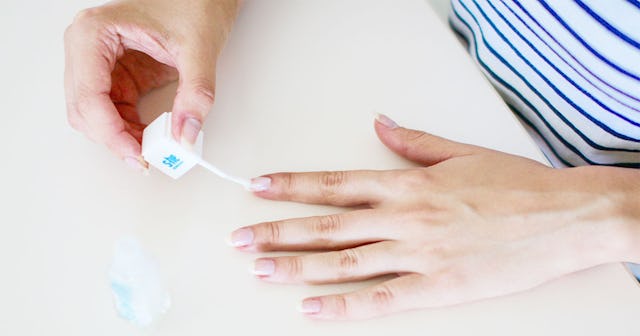What Your Fingernails Can Tell You About Your Health

Check your fingernails. If they aren’t coated in polish (and hey, pandemic, so they probably aren’t), you may notice all sorts of things. Are they long, strong, and hard? Or are they thin and flexible? Do they peel easily? Some people have ridges running vertically or horizontally along them; others may have small, white dots on some nails. Discolorations, puffiness, differences in thickness and thinness, lifting up from the nail bed — all of these things can tell a story about your overall health.
It only makes sense. Your fingernails are made of keratin, which also compromises your hair and your upper layer of skin cells, according to Healthline. The “nail” part? That’s dead, so it doesn’t hurt to cut your fingernails (tell your toddler that, amiright?). Your nail grows up from your cuticle, and they grow about 3.5 millimeters a month. That’s about a tenth of a millimeter per day, and if you lose one, it may take up to six months to grow back, and even longer if it’s a thumb. Healthline says they grow faster on your dominant hand, during the summer, and during the day. They also grow faster when you’re pregnant, and slower when you’re nursing.
Since nails grow so fast (compared to the rest of you), and renew themselves so visibly (also compared to the rest of you), they can tell us a lot about your health. Have a thyroid condition? Malnourished? Your nails are tattling on you. Here are some common nail conditions and how to decode them.
Vertical Lines Up and Down the Fingernail
This is one of the most common nail issues people have: uniform lines on their fingernails. According to the Cleveland Health Clinic, just as people may have hair fall out during times of stress, you may have lines appear on your fingernails. And who isn’t stressed right now?! These “prolonged periods” of stress can show up on your nails.
Brittle, Cracking, or Splitting Nails
These can show up for a multitude of reasons. Nails that crack or split easily can be a sign of malnutrition, says Medical News Today, though of course aging and lifestyle can also play a role. But so can thyroid disease and anemia, according to Penn Medicine. Thyroid disease generally means a low thyroid: your thyroid gland isn’t making enough hormones. A blood test can diagnose it. Anemia? Your red blood cells “lack enough hemoglobin, which carries oxygen from the lungs to the rest of the body.” Again, a blood test can figure it out.
Got Spots?
There are several kinds of spots you can find on fingernails: some normal, some not-so-normal, and some doctor-worthy.
Random white spots on your nails are called leukonychia. They’re harmless, but can indicate (again) malnutrition or nutritional deficiencies, according to Medical News Today, infections (i.e., while that part of the nail was growing, you had one), or metabolic diseases.
Dermatologist Christine Poblete-Lopez, MD, tells the Cleveland Clinic that “changes in nail color are one of the most common complaints dermatologists hear.” Discolorations usually run “from nail to tip,” and could be “benign moles or cancerous melanomas.” Talk to your doctor if you have any discoloration under your nailbed. If it runs into the cuticle and affects only one finger, it’s more likely to be a sign of melanoma.
All The Colors of Your Fingernails!
Got pale nails? Check yourself for malnutrition (again), anemia (again), congestive heart failure, or liver disease, says Aurora Healthcare. Yellow nails? If you haven’t been using too much nail polish or smoking too many cigarettes, yellow fingernails can indicate a fungal infection, chronic bronchitis, or, rarely, lung disease, diabetes, psoriasis, or thyroid disease. Blue nails? You aren’t getting enough oxygen! Think heart and lung problems. Or, possibly, being cold or consuming too much silver (stop eating your jewelry, Karen).
If that blue or green tint is from a bacterial infection of your fingernail, you will so know it by other signs, like redness or puffiness.
Got Weird Ridges?
Everyday Health says Beau’s Lines are lines that run across the nail (think the thickened ridges some people develop horizontally across their thumb). They can be a general sign of malnutrition and vitamin deficiency, or zinc deficiency in particular. They’re also associated with diabetes. If you suffered from scarlet fever, measles, mumps, or pneumonia while those parts of your fingernails were growing, you may see Beau’s Lines appear as well.
Is Your Fingernail Lifting Up?
Ewwww. We all hate this. But when your nail starts to lift up from your nail bed, there’s a reason. It can range, according to Aurora Health, from medication side effects, to thyroid disease (again), to pregnancy, to fungal infection, to nail trauma or psoriasis. So you might want to get that checked out.
You Keep Saying “Fungal Infection”
Yes, fungal infections are more common in toenails, but they can happen in fingernails, too. The signs are about the same, according to Family Doctor. Yellow nails, nails with crumbly ends, nails that are “brittle,” “thick,” or separating from the nail bed, nails that are curled up or down or distorted in shape likely have fungal infections.
So check your nails. They’ll tell on you. And if you have any symptom listed above, don’t play Dr. Google. Go see your family doctor, who will likely assure you that you’re fine. But even so, peace of mind is always a good idea. Especially when the answers are (literally) at your fingertips.
This article was originally published on